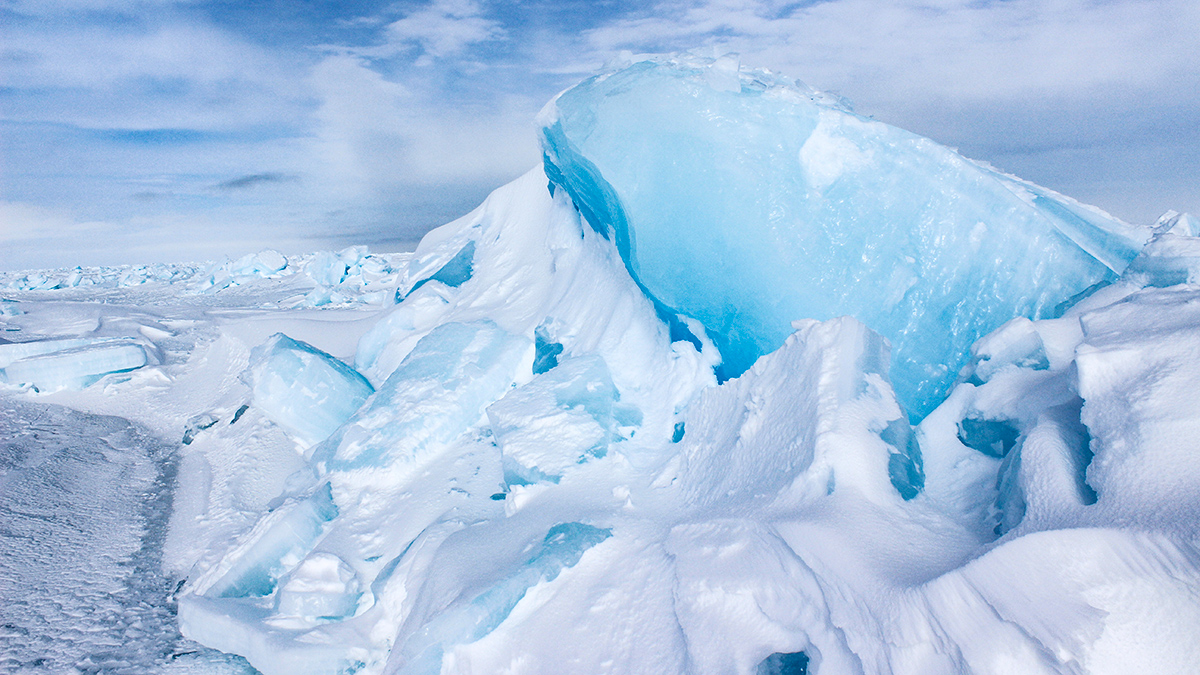The vast expanse of sea ice that covers Earth’s northernmost regions may look frozen in both time and temperature. In truth, the ice pack is in near-constant motion: flexing and breaking, flowing and piling up as winds and currents push it around the Arctic. These forces compact ice, creating thick ridges that are often spaced just a few hundred feet apart.
Sea ice ridges are havens for tiny marine organisms and anathema to icebreakers, which cannot push through the ridges’ underwater keels. These features, however, may not be around forever. A new study found that sea ice ridges are decreasing in both number and size, driven by a trend toward shorter-lived sea ice that cannot form such thick ridges.
It’s a trend that has likely been underway in the Arctic for decades, said study coauthor Thomas Krumpen, a sea ice physicist at the Alfred-Wegener-Institut (AWI) in Germany. What the loss of ridges means for the wider polar ice ecosystem is not yet clear.
“You find them everywhere in the Arctic. Every 200 meters or so you have a pressure ridge.”
In the study, Krumpen and his colleagues used 30 years of aerial ice observations. The data were culled from plane and helicopter surveys conducted by AWI above the Lincoln Sea and the outflow of the Transpolar Drift, both off northern Greenland. Laser altimeters took detailed readings of the ice surface height, picking out the characteristic sails of ice ridges that stick a few feet above the surface.
Like an iceberg, much of the bulk of these ridges hides beneath the surface in keels that can be more than a hundred feet thick.
“You find them everywhere in the Arctic,” Krumpen said. “Every 200 meters or so you have a pressure ridge.” He estimated there are several hundred million pressure ridges at any given time in the Arctic.
The researchers’ dataset, which was published in Nature Climate Change, reveals that the density of ice ridges in the region has decreased by around 4% per decade, and the ridges themselves have become smaller. The Transpolar Drift carries ice throughout the region, meaning that the changes the authors saw there likely represent ice ridge conditions for the Arctic as a whole, Krumpen said.
The culprit is the loss of older sea ice, which collects ever-thicker ridges each year. “Once all the old ice is gone and then you end up with a seasonal ice cover, you basically form pressure ridges, but then they melt,” Krumpen said.
The results are a bit surprising, Krumpen said. First-year ice is thinner and breaks and piles up more easily, forming about 4 times as many ridges per year as old ice. Though that is happening in the younger ice, he said, enough old ice is melting that more ridges are being lost than are being formed each year.
“This is a very chaotic process.”
That fact was surprising for another reason: Studies show that ice is moving faster than it had been previously, with one estimate putting the rate at around 10% faster per decade. Because ridges and keels act as sails, smoother ice should have meant less surface for air and water currents to act on, slowing the ice pack. Scientists are puzzling over why the opposite seems to be true.
“This is a very chaotic process,” said Einar Ólason, a sea ice modeler at Norway’s Nansen Center who wasn’t involved with the research. “It’s a lot of teasing out of what are the competing processes and how did they balance out in the end.”
Factors such as quickening ocean currents might be contributing to faster ice, according to the study’s authors. Understanding and including these things in future models will be important for understanding how sea ice will move in coming decades, Ólason said. Today, researchers’ models of Arctic ice remain imperfect, he added, making predicting how fewer ice ridges will affect ice behavior in the future difficult.
Making matters more challenging is that much of the old, multiyear sea ice likely melted since the 1980s but before large-scale monitoring began.
“Old papers have a completely different view on ridges, because ice was so different,” said Evgenii Salganik, a postdoc studying sea ice at the Norsk Polarinstitutt who wasn’t affiliated with the research. That makes comparing estimates from different eras to see how things like changes to ice ridges affect the broader Arctic more difficult, according to Salganik.
Fewer Ridges Mark a Changing Arctic
The marked decrease in ice ridges will almost certainly change the Arctic landscape. These topographic features collect snow in winter and accelerate melt pond formation in warmer months—both important factors in ice formation and retreat.
“Melt ponds, they actually can have quite an impact on the sea ice retreat, because they take up heat,” Krumpen said. Smaller ridges tend to create wider but shallower melt ponds, which decrease the ice’s albedo, leading to more melting, he said.
The formations are also havens for Arctic sea life, especially microorganisms such as algae that live in sea ice. Fewer ridges mean fewer places for these organisms to live, a change that could reverberate through the food chain.
It’s not known exactly what will happen to the life contained in ridges, or to the ice pack more broadly. But it is clear that change is happening quickly, something the new study underlined. The findings should be of great interest to others studying the Arctic, Krumpen said.
—Nathaniel Scharping (@nathanielscharp), Science Writer

